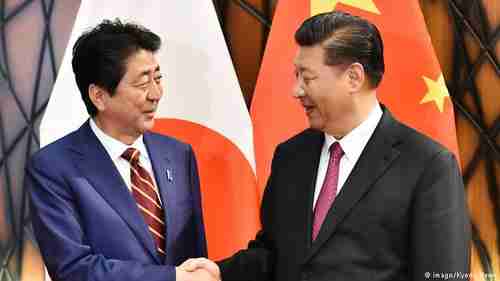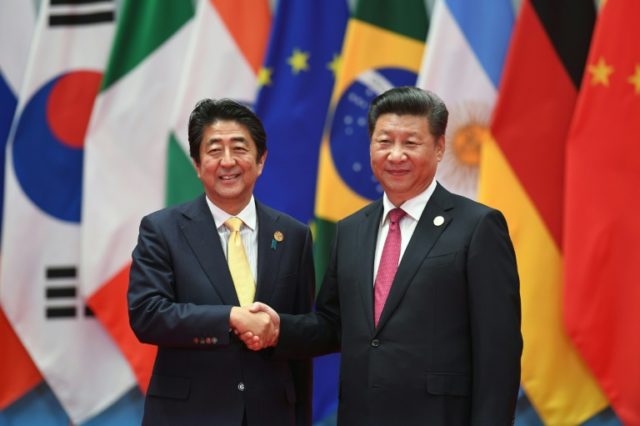This morning’s key headlines from GenerationalDynamics.com
- China, facing Trump’s trade challenge, appears to mend ties with Japan
- China and Japan’s ‘marriage of convenience’ limited by bitter history
China, facing Trump’s trade challenge, appears to mend ties with Japan

Shinzo Abe and Xi Jinping (Kyodo News)
There have been numerous reports in the last three months that, with the Trump administration imposing reciprocal tariffs on hundreds of billions of dollars’ worth of Chinese exports to the U.S., China has been scrambling to find new markets for its exports.
One of those new markets appears to be Japan. As Japan’s Prime Minister Shinzo Abe visited China’s capital city Beijing on Friday, the two countries signed several deals and declared a new era of cooperation between the two countries.
China’s President Xi Jinping on Friday rolled out the red carpet for Abe and said:
Our relationship has encountered a lot of obstacles. It was not a smooth ride. But with our joint effort, the relationship has become more normalized. A healthy relationship between China and Japan serves the basic interests of both countries.
Abe responded by saying that he hoped his trip would elevate the China-Japan relationship from competition to cooperation: “China and Japan are neighbors and partners, and we will not be a threat to each other.”
One of the deals was a currency swap deal. Under the deal, the People’s Bank of China and the Bank of Japan will be able to exchange up to 3.4 trillion yen for 200 billion yuan (about $29 billion) and vice versa over the next three years – a design that will help to ensure financial stability and facilitate financial ties and allow commercial trade involving the two currencies without needing to go through the US dollar as an intermediary.
The sides also signed about 50 agreements on boosting cooperation in third-party countries, while companies agreed to more than 500 business deals. The third-party country deals are said to be cooperative infrastructure projects related to China’s Belt and Road Initiative (BRI).
The two sides also agreed to open a hotline “as soon as possible” to prevent accidental clashes at sea and in the air in the East China Sea, where Chinese ships have been harassing Japanese ships near the Senkaku Islands. South China Morning Post (Hong Kong) and Japan Today and South China Morning Post and Deutsche Welle
China and Japan’s ‘marriage of convenience’ limited by bitter history
China and Japan have a long, bitter history going back centuries. In recent times, the Sino-Japanese war (1894-95) was a major humiliation for China, which was forced to cede Taiwan to Japan as a colony.
Even more recently, in December 1937, Imperial Japanese troops in China perpetrated the Nanjing (Nanking) Massacre. This event, along with the Japanese army’s use of Korean and Chinese women as “comfort women” during World War II. Japanese troops did not leave China until they were defeated by the Americans at the end of World War II.
During the last ten years, Chinese ships have been constantly harassing Japanese ships around the Senkaku Islands. These islands, in the East China Sea, are governed by Japan. Like many places belonging to other countries across Asia, China is threatening to annex them by force. However, this would trigger a war with the U.S. under a Japan-U.S. mutual defense treaty.
China has its own concerns about Japan. Under Shinzo Abe, Japan has all but abandoned its defense-only policy adopted after World War II and been strengthening its military for the first time in decades, which China sees as a threat.
The hatred that many Chinese people viscerally feel for the Japanese runs deep. There have been frequent anti-Japan protests in China. One of the biggest occurred in 2012 when more than 70,000 Chinese staged rallies Saturday in at least 28 cities to demand that Japan surrender the Senkaku islands to China. The largest demonstration, in Qingdao, Shandong Province, attracted as many as 30,000 people and evolved into rioting as protestors torched as many as ten Japanese enterprises, including a Panasonic factory. The protests and violence appeared to have the tacit approval of China’s government.
The current rapprochement between China and Japan may be a marriage of convenience, but the core issues separating the countries runs deep. Generational Dynamics predicts that Japan and China will fight a new generational crisis war as part of the Clash of Civilizations world war that will pit the US, India, Russia, and Iran versus China, Pakistan and the Sunni Muslim countries. Deutsche Welle and National Interest and BBC and Diplomat
Related Articles
- Chinese commemorate the 1937 Massacre at Nanking (Nanjing) (18-Dec-2007)
- Japan bolsters defenses as 1,000 Chinese fishing boats approach (18-Sep-2012)
- Huge Anti-Japan protests spread across China, turn violent (16-Sep-2012)
KEYS: Generational Dynamics, Japan, Shinzo Abe, China, Xi Jinping, Senkaku Islands, Sino-Japanese war, Taiwan, Nanjing Massacre, Nanking Massacre
Permanent web link to this article
Receive daily World View columns by e-mail

COMMENTS
Please let us know if you're having issues with commenting.